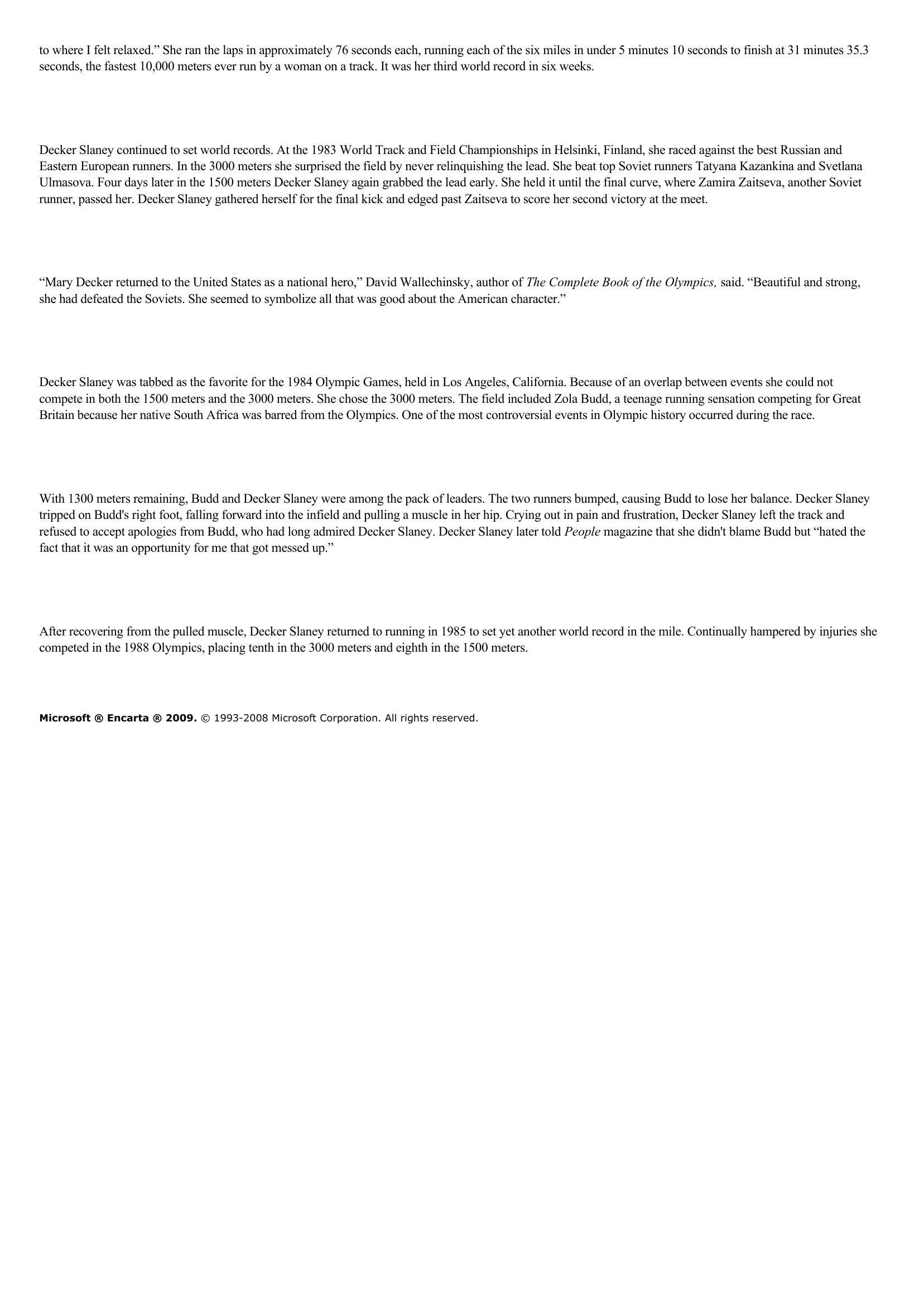Decker Slaney Goes the Distance.
Publié le 14/05/2013

Extrait du document
«
to where I felt relaxed.” She ran the laps in approximately 76 seconds each, running each of the six miles in under 5 minutes 10 seconds to finish at 31 minutes 35.3seconds, the fastest 10,000 meters ever run by a woman on a track.
It was her third world record in six weeks.
Decker Slaney continued to set world records.
At the 1983 World Track and Field Championships in Helsinki, Finland, she raced against the best Russian andEastern European runners.
In the 3000 meters she surprised the field by never relinquishing the lead.
She beat top Soviet runners Tatyana Kazankina and SvetlanaUlmasova.
Four days later in the 1500 meters Decker Slaney again grabbed the lead early.
She held it until the final curve, where Zamira Zaitseva, another Sovietrunner, passed her.
Decker Slaney gathered herself for the final kick and edged past Zaitseva to score her second victory at the meet.
“Mary Decker returned to the United States as a national hero,” David Wallechinsky, author of The Complete Book of the Olympics, said.
“Beautiful and strong, she had defeated the Soviets.
She seemed to symbolize all that was good about the American character.”
Decker Slaney was tabbed as the favorite for the 1984 Olympic Games, held in Los Angeles, California.
Because of an overlap between events she could notcompete in both the 1500 meters and the 3000 meters.
She chose the 3000 meters.
The field included Zola Budd, a teenage running sensation competing for GreatBritain because her native South Africa was barred from the Olympics.
One of the most controversial events in Olympic history occurred during the race.
With 1300 meters remaining, Budd and Decker Slaney were among the pack of leaders.
The two runners bumped, causing Budd to lose her balance.
Decker Slaneytripped on Budd's right foot, falling forward into the infield and pulling a muscle in her hip.
Crying out in pain and frustration, Decker Slaney left the track andrefused to accept apologies from Budd, who had long admired Decker Slaney.
Decker Slaney later told People magazine that she didn't blame Budd but “hated the fact that it was an opportunity for me that got messed up.”
After recovering from the pulled muscle, Decker Slaney returned to running in 1985 to set yet another world record in the mile.
Continually hampered by injuries shecompeted in the 1988 Olympics, placing tenth in the 3000 meters and eighth in the 1500 meters.
Microsoft ® Encarta ® 2009. © 1993-2008 Microsoft Corporation.
All rights reserved..
»
↓↓↓ APERÇU DU DOCUMENT ↓↓↓
Liens utiles
- Deification In mythology, the process of bestowing upon a mortal the status of a god; also, the process a mortal goes through to transform into a god.
- exposé anglais introduction to the Consumer Society
- Le théâtre a-t-il pour fonction de tout dire, de tout expliquer au spectateur de la crise que vivent les personnages? - Par quels moyens et quelles fonctions Juste la Fin du monde est une pièce qui nous retrace la crise de cette famille?
- Ideology and Rationality in the History of the Life Sciences
- is the cultural difference a barrier between individuals.

































